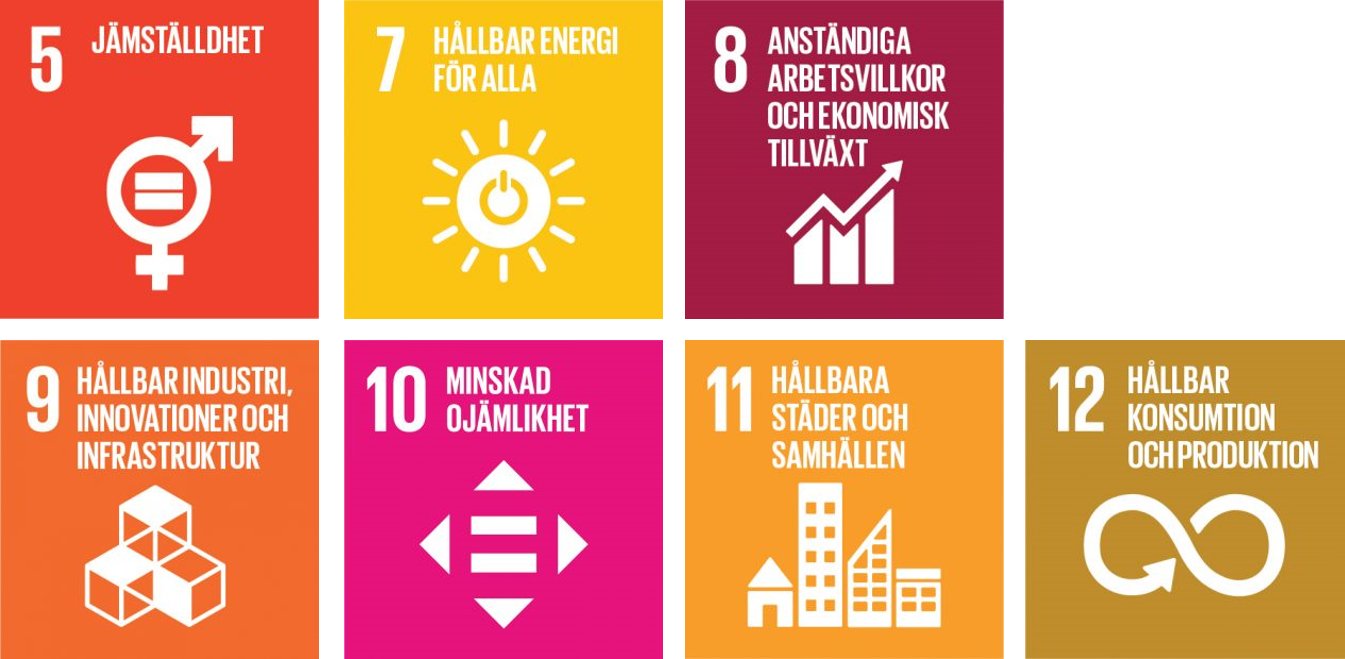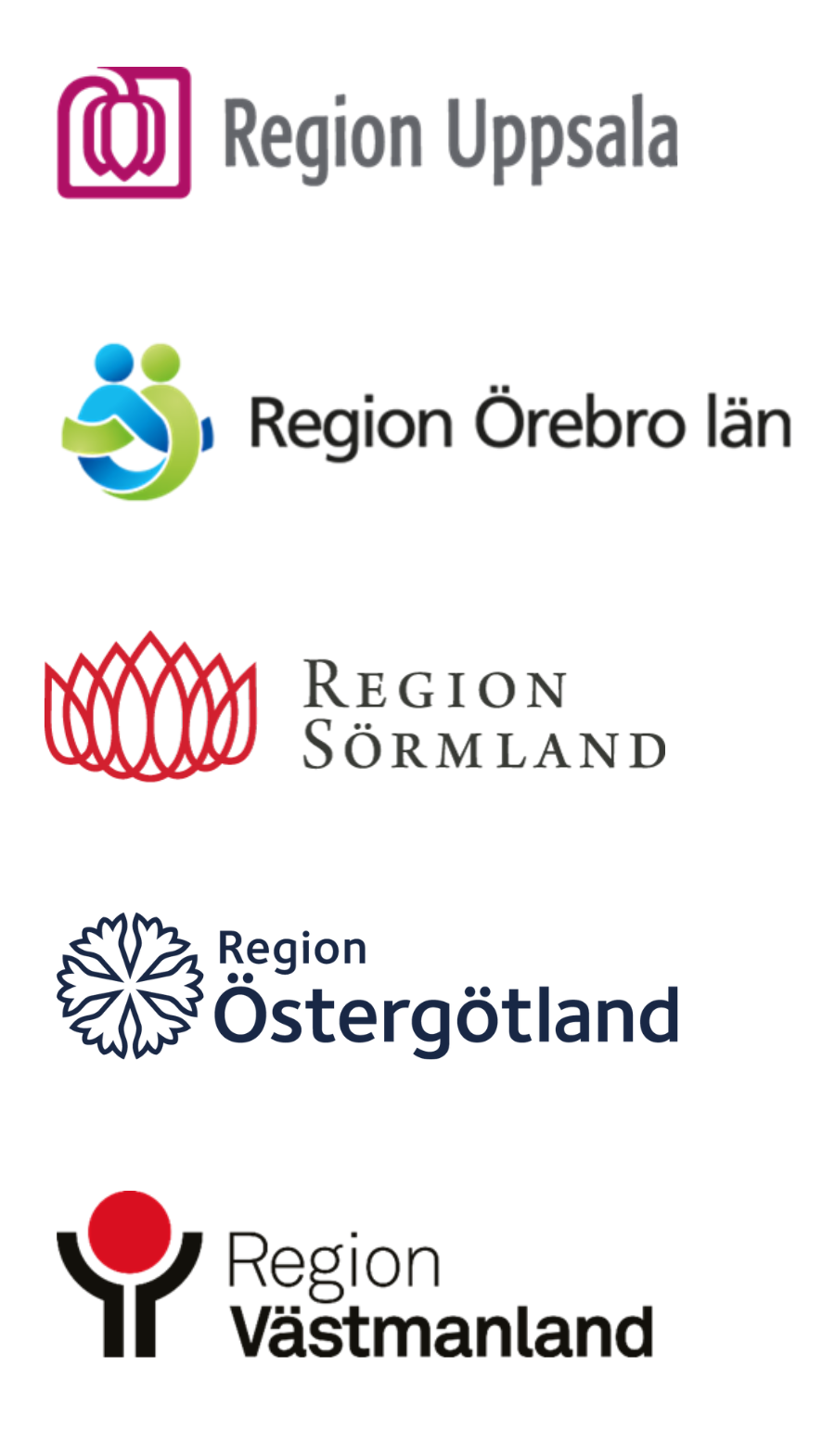Roadmaps East Middle Sweden 2023-2027
Roadmaps for common challenge areas within Smart Specialisation in East Middle Sweden.
About the roadmaps
The five regions of East Middle Sweden (EMS) cooperate closely for smart and sustainable innovation and growth. By using Smart Specialisation we have identified four common challenge areas in which we can make a difference. As we are responsible for our regions’ development and Smart Specialisation work, part of our assignment is to develop road maps connected to the EU regional fund programme and political goals. The purpose of the roadmaps is to pinpoint the project directions that we consider particularly important for the development of EMS. They will also serve as a kind of guidance for the design of calls within the program period.
The plans provide the current situation and driving forces for innovation, desired status of the challenge areas by 2027, prioritised directions for the work, connections to global goals, and proposals for actions or investments related to the areas’ respective focus. The prioritized directions are mainly thematical niches and sectors within each challenge area. These directions have been identified through dialogues between the regional development authorities and actors of EMS’s innovation system, as they feature international excellence and regional competitiveness.
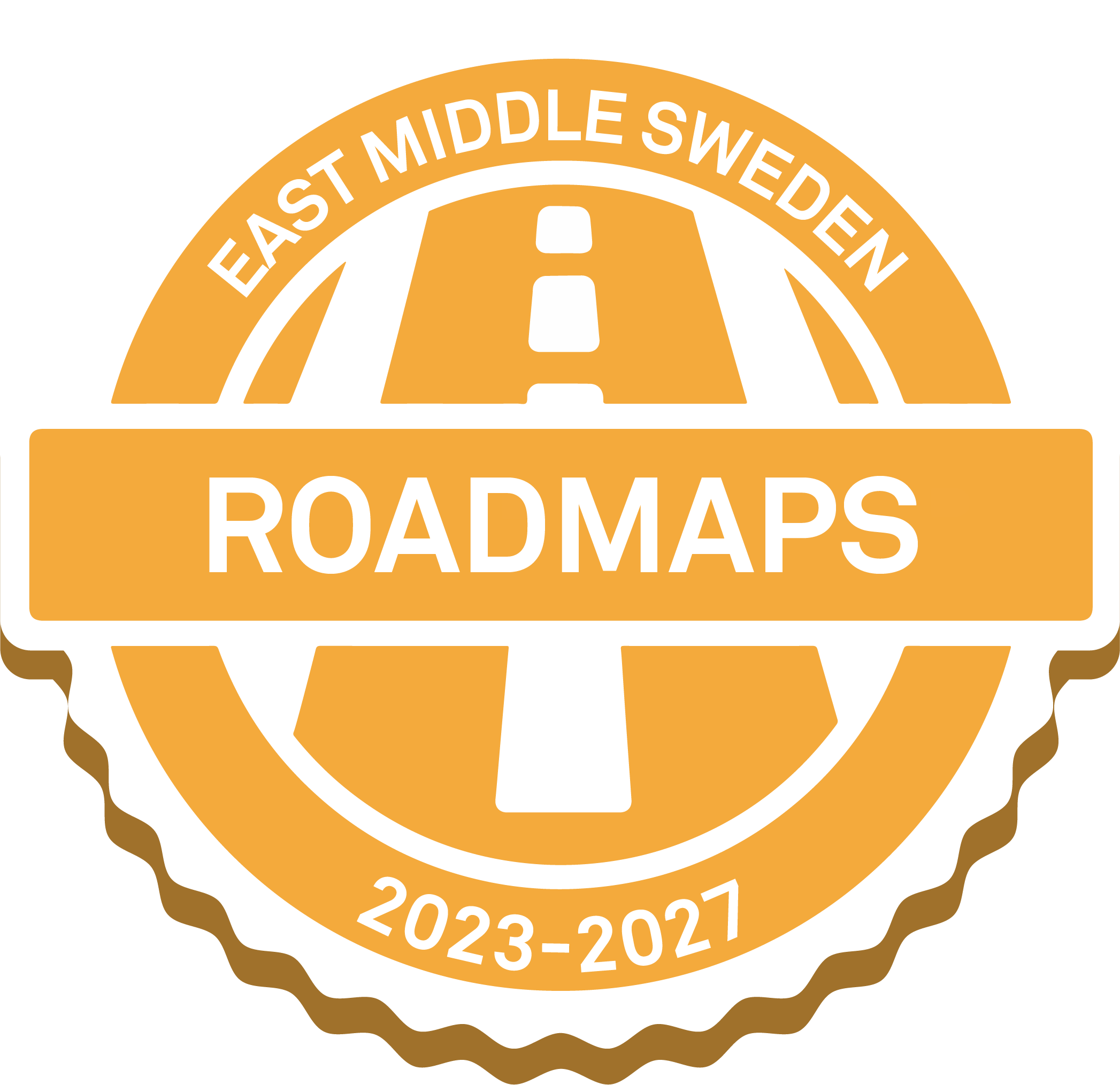
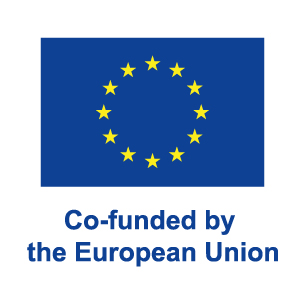
1. Sustainable food supply
East Middle Sweden (EMS) is one the most robust food regions in the country. Five universities, innovative businesses, and a large number of actors and innovation platforms drive progress. The region holds about 23 percent of Swedish agricultural land with around 6,700 employees in need of measures for transitioning to a more sustainable and innovative food production.
- Current state -
The demand for food is increasing in parallel to the growing population, nationally and globally. Our food system needs to be transformed to become more sustainable for both people and the environment. A crucial point for sustainable food supply is where and how food is produced. The consolidation of the food industry means a reduced number of workplaces and employees, but increased productivity. Profitability remains constant but is lowest for food companies in the agricultural sphere.
Based on the national food strategy and the ongoing cooperation within Smart Specialisation in EMS has a significant need of a transition towards sustainable food production and increased innovation capacity. Therefore, food is a very important matter across the EMS regions. There are a number of strong regional and cross-regional cooperations between stakeholders, actors, and regions. We need to enhance cooperation and efforts related to digitalisation, research, and innovation, while working with aspects that counteract innovation and transition, such as culture and values.
- Drivers of innovation -
To secure a sustainable food supply, we need to meet challenges such as insufficient profitability, strong need for new competence within multiple sectors, tough international competition, and global challenges like climate change and other environmental issues.
Competitiveness needs to be strengthened, new technology embraced in the development of new business models, and increased sustainable production and innovative food processing must be encouraged. This is what it takes to boost demand in new markets. For the challenges within the food chain there are also opportunities such as digitalisation, increased research, and innovation.
EMS has substantial assets across the entire chain, from primary production, via processing and packaging, to the trade and consumer areas, as well as a highly developed innovation system. There are evident links to development initiatives related to other challenge areas in EMS and several of the region’s strong areas. According to the national food strategy, our food chain should be globally competitive, innovative, sustainable, and attractive to work within. An enhanced cooperation in EMS will create opportunities to reach international markets in partnership with other food regions, strong universities, and a robust support system. Companies will also have better conditions for developing new solutions together with customer, by cross-connecting agriculture and the food industry with benefits in other challenge areas and the region’s areas of expertise, for example smart industry, advanced materials, and visualisation. A more cohesive and developed innovation system will also provide smaller companies with the opportunity to use test beds for testing new solutions based on the needs of larger companies and those diversifying for increased productivity and competitiveness.
- Desired state -
By 2027 the food chain in EMS is globally competitive, innovative, sustainable, and attractive to operate within. There are great assets across the entire food chain, from primary production through processing and packaging, to the trade and consumer area, as well as support within a highly developed innovation system. New technology is embraced in the development of new business models, encouraging a reinforced local circular production and innovative food processing. Our food technology is sought after on international markets. We make use of the opportunities connected to other challenge areas and several of the region’s areas of expertise.
- Prioritised directions 2023-2027 -
Strengthened supply security, as well as increased robustness and resilience
This direction covers the ability to be self-sufficient and to strengthen supply security. This will require more innovations and utilization of digital tools. Emphasis lies in research in digital innovations and new types of companies focusing on tomorrow’s agricultural inventions.
Enhanced sustainable food chain
The direction comprises sustainable business models and offerings in an integrated food chain, which is a prerequisite for creating demand in new markets. This involves new model, techniques, and concepts, as well as actors. Sustainable business models also need to address both gender equality and social entrepreneurship.
Resource-efficient and innovative food production
This direction includes increased and streamlined production through innovative methods such as local circularity, vertical farming, and protein development. In addition, there are opportunities for investments related to business development and entrepreneurship.
- Examples of initiatives -
- Initiatives that boost digital maturity and awareness of safe digitalisation of tomorrow’s food supply.
- Initiatives that enable test beds where the safety of the entire food chain can be tested.
- Initiatives that build preparedness among public and private actors to enhance supply security.
- Initiatives that strengthen the opportunities to create industrial symbiosis for sustainability and supply security.
- Initiatives that promote more circular solutions and business models in order to reduce the use of fossil fuels and energy.
- Initiatives that benefit the interregional food support system through investments in interregional hubs, food accelerators, and R&D facilitators.
- Initiatives that develop arenas, networks, and test environments enabling tech companies to test and develop their offerings together with the food industry.
- Initiatives that contribute to the future food production through digital tools, service innovation, sustainable services, and methods such as protein development and vertical farming.
- Initiatives that enable more small and medium-sized companies to invest in skills related to industrial transition and entrepreneurship in the food sector.
- Examples of measures related to other areas -
Life Science, welfare technology and e-health
- Test beds for future food production to increase self-sufficiency.
Smart industry
- Industrial technology for increased food production, thus reinforcing robustness and resilience.
- Technology for the utilisation of data within and between different parts of the food chain.
Tomorrow’s energy solutions
- Energy solutions for more energy-efficent and carbon-neutral food production and food chain.
-Energy solutions for increased energy production without impairing crop/forest land yield.
Other regional strong areas
- Innovative materials, environmental benefits that drive business, smart, secure and connected products and systems, visualisation, simulation and image analysis, circular bioeconomy, and autonomous digitalised intelligent systems.
- Relevant global goals -
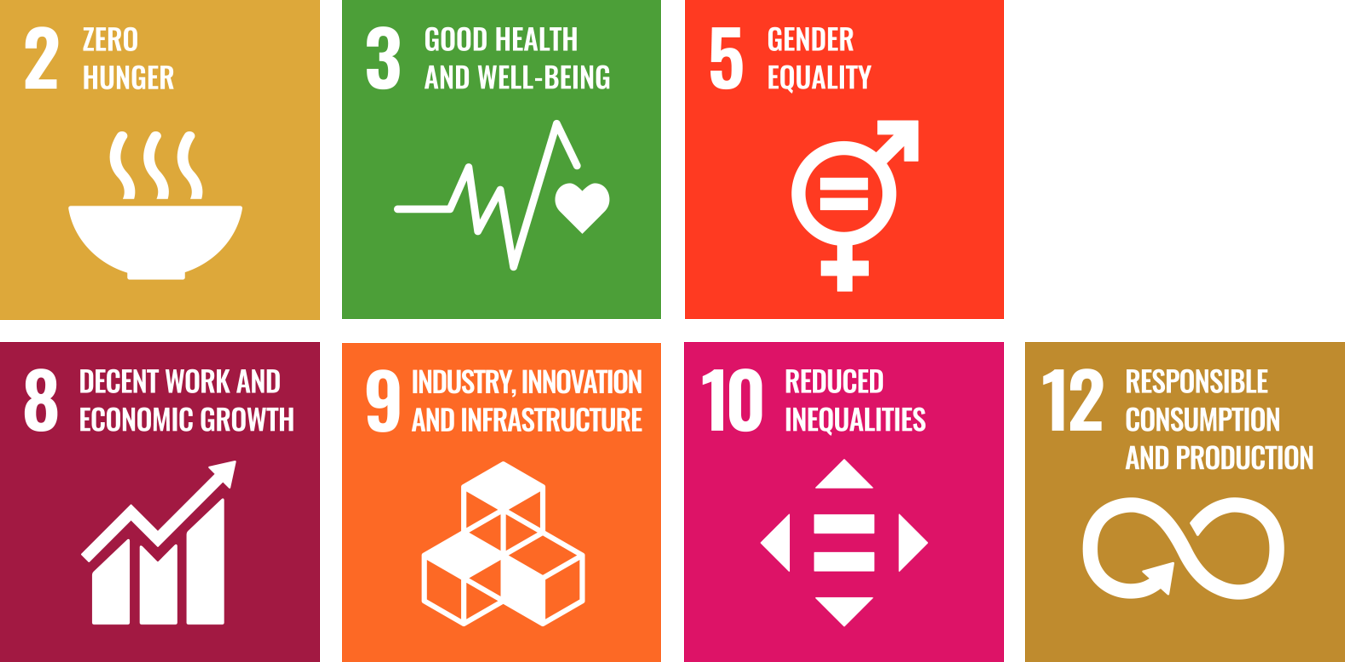
2. Life science, welfare technology, and e-health
East Middle Sweden (EMS) has several university hospitals, prominent research environments, and a vibrant startup scene driving progress within the challenge area. The region is also home to several major companies within the private life science sector. The majority of the 7,500 people employed in the region within this sector work for these large corporations. At the same time, 80 percent of the active companies are either micro, small or medium-sized enterprises.
- Current state -
The development of the area is closely intertwined with the needs and development conditions within the healthcare sector – today and tomorrow. The healthcare sector is facing significant challenges where for example demographic trends such as an aging population demand innovative thinking and development of both welfare technology and approaches to organizing the welfare sector. The area is characterized by academically-driven innovation, paving the way for groundbreaking medical advancements, as well as everyday innovations with direct benefits for daily healthcare production – clinically, organisationally, and culturally.
Surrounding the life science industry there is a supportive service sector, including venture capital actors, specialized consultancy, and specialized service companies in areas such as industrial IT, technology, and law. This ecosystem of actors within academia, business, and privately and publicly driven healthcare, is characterized by mutual dependence for both survival and progress.
The area is based on the national strategy for life science and the national initiative “Vision eHealth 2025” where multiple areas are highlighted, including structures for collaboration, utilisation of health and care data for research and innovation, as well as welfare technology for increased independence, participation, and health. The area also supports Business Sweden’s business ecosystems “Life Science” and “Sustainable Lifestyle”, as well as Vinnova’s designated societal challenge “Sustainable Precision Health”. EMS meets these challenges by constantly exploring new forms of development for innovative solutions that offer more efficient care, better health, and quality of life for patients.
- Drivers of innovation -
EMS’s demographic is evolving, with an aging population and changing care needs, which demand a renewal of healthcare production. Efforts promoting health and preventing illness become even more important to relieve and contribute to more efficient healthcare. New techniques and advancements in precision medicine enable individualized diagnostics and treatments, where biological drugs play a crucial role. We are amid the so-called fourth industrial revolution, where technological, biological, and digital technologies create new rules of the game and industry definitions, requiring new forms of collaboration to secure the future competitiveness of the sector and the companies.
At the same time, the increased risk of global pandemics and the spread of antibiotic resistance, which complicates disease treatments and affects food production, is a substantial threat. These challenges require us to collaborate across borders, share data and knowledge, and rapidly accelerate the development of new vaccines and treatment methods. Here structural and regulatory slowness is a challenge, as it suppresses innovation due to difficulties in making health data accessible and conducting clinical studies.
- Desired state -
By 2027 EMS contributes to the interaction between the healthcare sector and the business community, paving the way for mutual advancements: more efficient healthcare production, greater patient benefits, and needs-based innovation in companies. As an early development partner for both businesses and research, healthcare is a pioneer and acts as a testing ground and transparent procurer of solution-oriented products and services.
Furthermore, EMS is one of Europe’s leading innovation hubs – a favourable “breeding ground”, attracting investments and establishments, and encouraging existing Life Science companies, both large and small, to remain and continue their developmental journey in the region. In EMS, innovative cooperation between the life science sector and healthcare contributes to finding answers to the health challenges of modern society.
- Prioritised directions 2023-2027 -
Precision medicine, biological drugs, and precise drug delivery
The direction includes gene sequencing, personalised diagnostics and therapies, as well as next-generation targeted drugs (biological therapies) – from cell culture, purification of healing substances, to scaling up production from lab to industrial scale.
Material Development and Additive Manufacturing Methods
The direction encompasses development of materials, production techniques, processes, and business models that enable the streamlining of healthcare and patient-specific solutions.
Utilisation of health and healthcare care data, and clinical trials
This direction includes all aspects of using systematic health and healthcare data, as well as clinical trials that serve a basis for innovation, healthcare renewal, and patient-centered solutions.
Healthcare as a needs-driven testbed for innovation and renewal
The direction covers under which conditions the sector can act as an early and active partner in business innovation development based on clinical and organisational needs. The aim is to strengthen the willingness, capacity, and mandate to ultimately implement solutions in healthcare or social care.
- Examples of initiatives -
- Initiatives that strengthen the healthcare’s ability to act as an early, transparent development partner and testbed for new solutions.
- Initiatives that enhance healthcare’s conditions for implementing and utilising existing solutions.
- Initiatives that improve the business sector’s understanding of working with healthcare as a market.
- Initiatives that challenge and remove obstacles in public procurement regulations (LOU) as a potential tool for innovation and renewal in cooperation between small/medium-sized enterprises and healthcare.
- Initiatives that reinforce innovation ecosystems within thematic areas, such as prevention, precision medicine, open health data, additive manufacturing for patient-specific solutions, etc.
- Initiatives that enhance testing opportunities for the validation and verification of early innovations.
- Initiatives that cross-connect expertise for innovation at the borderland between technology, biology, and digitalisation.
- Initiatives that strengthen competence within the business sector on different levels, such as business development, sustainability, digitalisation, internationalisation, etc.
- Exemples of measures related to other areas -
Sustainable food supply
- The field of knowledge “One Health” creates an understanding of how diseases emerge and spread between animals, humans, and the environment. For example, the origin and processing of food are connected to antibiotic resistance and the development of future medicines.
Smart industry
- The emergence of biological drugs is more about “engineering”, where innovations grow in the borderland between biology, technology, and digitalisation. There are connections between process technology and digitalised industrial production, in Smart industry on one hand, and the Life science sector on the other. Other examples include industrial 3D printing and advanced imaging, enabling revolutionary patient-specific solutions.
Tomorrow’s energy solutions
- Like other industrial sectors, the Life science sector needs to contribute to the green and more carbon-efficient societal transformation. There is potential for cross-sector mutual learning and the exchange of solutions as well as expertise.
- Relevant global goals -
3. Smart industry
In East Middle Sweden (EMS) there are approximately 30,000 companies within the industrial sector and industrial-related research and development services. These employ about 25 percent of the total workforce in the region. Of all employees within the industry, 25 percent are women and 75 percent are men.
- Current state -
The industry is currently undergoing an intense digital transformation and must also in a short time become environmentally sustainable. Swedish industry operates in an international market with nearly 70 percent of production going for export, primarily within Europe. Recent years have been characterized by global challenges like increased protectionism, new trade barriers, and geopolitical uncertainties. These put pressure on the companies’ ability to quickly adapt to unexpected events.
This area aligns with the national industrial strategy “Industry of the future”, a strategy for green and digital transformation for increased competitiveness, as well as the EU’s industrial strategy. Development work focuses on utilising regional strengths within the industry and the interregional innovation ecosystem, digitalisation expertise, and making use of research and education at our universities in cooperation with the business sector and society.
In EMS, stakeholders are driving towards a long-term sustainable and fossil-independent industrial sector. There are also strong regional and interregional cooperations among companies, customers, stakeholders, and regions. The region is home to globally strong industrial companies. Significant portions of Sweden's industrial service companies and strategically important players in the defense industry are also located in our geography
- Drivers of innovation -
The accelerating digitalisation, the demand for a rapid transition to more sustainable production, and increasing global competition require a higher pace of the transformation efforts. The ecosystem needs to be developed to function seamlessly within and between regions, both in EMS and on a national and international level. We need intermediaries who understand both new technology and the resources of the innovation support system, as well as the needs of industrial companies and their value chains, to ensure that as many companies as possible can benefit from of the opportunities offered. A well-functioning strategic talent supply is crucial for us to meet the challenges and capitalizing on the significant opportunities we see for the future of industry in EMS. Our strengths in thematic areas and strong industrial sectors have excellent potential to contribute to this development.
Investments are needed both in breadth and depth. Developed collaborations are required, both within the innovation system and between academia and industry, as well as between small and large companies, where especially our many subcontractors need to be included. The transition ability requires capacity building and investments in new knowledge, new methods, and processes, along with the accessibility of product and test environments for companies. It also involves creating an understanding of the impact of industrial digitalization on, for instance, business models throughout the entire production chain, including distribution and after-sales. New production technology also enables industrial use of entirely new materials and gives rises to new business models and changed logistics chains. Deteriorating security situations mean major challenges and require increased digitalisation, cyber security, and security protection within the industry.
- Desired state -
By 2027, EMS holds a leading position with expertise in the next generation of development for industrial excellence. Our industry is at the forefront, contributing to the transformation and competitiveness of strategic value chains for long-term sustainable societies. Strong innovation environments lead national development in close cooperation with small and large companies in several technological fields, such as electrification, AI, smart materials, digitalised production, automation, and visualisation. Established structures align industry competence needs with individual adaptability. The role of universities and other educational institutions as suppliers of competence to the industrial sector has been strengthened.
- Prioritised directions 2023-2027 -
Digitalisation and sustainability for global competitiveness
The direction involves increasing and utilising applied research and digital technology throughout the production or value chain, both within and between companies. It also encompasses the development of products, processes, and business models that contribute to new or improved technologies, goods, and services in terms of for example reduced emissions, efficiency, recyclability, and environmental performance. Active sustainability efforts ensure both gender equality and equity aspects.
Research, innovation, and enhanced capacity for industrial transformation
This direction involves promoting and developing platforms where research environments, clusters, companies, and organisations can meet and develop innovative solutions related to contemporary and future societal challenges and needs.
Enhanced resilience and security
The direction covers creating conditions for strong adaptability, where the industry is prepared to tackle challenges that cannot be predicted with certainty. These challenges may include various crises and security threats such as shortages of raw materials and/or components, pandemics, industrial espionage, and sabotage against critical infrastructure.
- Examples of initiatives -
- Initiatives that strengthen the innovation capability and transformation ability
- Initiatives that make testbeds and test environments accessible
- Sustainability initiatives as leverage to generate increased growth in companies
- Initiatives that promote circularity and industrial symbiosis
- Initiatives that provide more small and medium-sized companies with enhanced skills related to industrial transformation and entrepreneurship
- Initiatives to strengthen the strategic competence supply for industrial companies
- Initiatives related to material development in symbiosis with new production technologies
- Initiatives that contribute increased production in Sweden
- Initiatives that encourage contacts and knowledge exchange between academia and industry
- Initiatives for international business development that help companies to consolidate their position on the market. This should be done in cooperation with national and international resources and stakeholders.
- Examples of measures related to other areas -
Sustainable food supply
- Industrial technology for increased food production and thereby enforced robustness and resilience.
- Technology for the untilisation of data within and between different parts of the food chain.
Life science, welfare technology, and e-Health
- 3D printing of individually designed organs for education and improved surgical planning.
- Utilization of health and healthcare data, as well as clinical trials.
Tomorrow’s energy solutions
- Industrial technology and automation for resource and energy efficiency, industrial symbiosis, and sustainable communities.
- Autonomous systems for sustainable transports of the future.
- Relevant global goals -

4. Tomorrow’s energy solutions
Did you know that East Middle Sweden (EMS) holds as much as 35 percent of Sweden’s energy expertise, 33 percent of Sweden’s automotive industry, and 7 percent of the world’s total automation industry?
- Current state -
Electrification and the transition to a more fossil-free society are global and regional challenges, as well as opportunities for growth. The energy sector, including transportation and cities, accounts for 70 percent of the total greenhouse gas emissions in Sweden. The need for fossil-free production methods, smart, safe, and resilient distribution channels and storage, as well as energy efficiency and optimisation that lead to secured capacity and reduced carbon emissions, is already reshaping the energy landscape in Sweden and globally. Here, the business community, communities, and public organisations in EMS have the opportunity to be an even stronger driving force for innovation and the implementation of new solutions, goods, and services.
Energy, electrification, and energy transition are currently strong business sectors in EMS. They need to continue evolving and receiving support to maintain their global position. This region has both large global industry-leading companies in the energy sector and emerging growth companies with future global solutions. There are several universities with cutting-edge research within solar cells, biofuels, industrial symbiosis, control systems, and power systems. In the region there are also multiple energy companies and major cities at the forefront of the energy transition.
The challenge area works in line with the national climate and environmental goal of net-zero greenhouse gas emissions by 2045 and then negative emissions. The work also aligns with the Energy Agreement, the Swedish Energy Agency’s sectoral strategies for energy efficiency, FOI’s (Swedish Defence Research Agency) strategies for energy transition, Business Sweden’s initiative for Smart Energy and Smart Transportation, and Vinnova’s areas of Sustainable Urban Development and Sustainable Mobility.
- Drivers of innovation -
The energy transition to a sustainable society puts new demands on the holistic view of the energy systems. This transition covers the energy sector, our cities, industries and a broader business environment such as the transport sector. But it also affects the civil society which needs to be included. Digitalisation enables new solutions in areas such as real estate, distribution, business models, and transportation, but also means higher requirements for cybersecurity and service design. A key to success in this challenge area is to involve stakeholders, suppliers, and policymakers early in the process.
The main focus of this area is to leverage strengths within the regional energy sector for innovation and green transition, in combination with other smart specialisation areas, such as AI, cybersecurity, visualisation, and new materials. This challenge area covers all three stages of energy: production, distribution and storage, and consumption.
Additionally, the intersections and benefits of efforts and developments in other challenge areas are central to creating tomorrow’s energy solutions. Smart industry and sustainable food supply both require energy transition but also contribute with infrastructure, requirements, test beds, and innovation and production partners for the energy sector. A well-functioning strategic competence supply is also a crucial factor for us to meet the challenges and preserve the great opportunities for the future energy sector in EMS.
- Desired situation -
By 2027, EMS is an internationally attractive energy region that meets global and regional energy needs with world-class sustainable energy solutions. Here, the business sector and regional strengths within the energy sector are developed by leveraging both regional infrastructure and smart specialisation efforts on a regional, national, and international level. Research and innovation, development, and testing lead to globally commercialised new solutions and create sustainable regional growth in the business sector. Established structures and educational institutions match and meet the energy sector’s competence needs through the adaptability of individuals. Research schools, education, and lifelong learning are a natural part of this work. The efforts within Tomorrow’s energy solutions contribute to the national mobilisation that is necessary for Sweden to become the world’s first fossil-free welfare society.
- Prioritised directions 2023-2027 -
Sustainable societies, resource and energy efficiency, and industrial symbiosis
Among other things, this direction includes the borderland where information technology and infrastructure meet new technologies and business models as a tool for digitalising, streamlining and providing capacity in a modern system view. The direction also includes CCS (carbon capture and storage)and negative emissions.
Electromobility, batteries, future transportation, and logistics solutions
This direction covers both the technologies required for future holistic transportation solutions, such as batteries, electric drivetrains, and fully connected vehicles, as well as the business models, services, and logistics solutions, behavioral development, and policy work needed for efficient implementation.
Renewable energy production, robust power grids, and energy storage
This direction includes aspects like carbon-neutral production (solar power, biogas, hydrogen, and wind power), both large and small scale, new and future energy sources, circular energy markets, as well as new, secure, and robust power grids for increased capacity and efficiency.
- Examples of initiatives -
- Initiatives for research and commercialisation of key solutions for the energy transiton, such as district heating, batteries and storage, services, and symbiosis.
- Initiatives for R&D projects outside the programm area, for example through cooperation with LeadIt, I3, EU Green Deal, ERA, and Horizon Europe.
- Initiatives for innovative policy pilots, like local electricity markets.
- Innovation projects focusing on behaviour change, consumption patterns, and the role of transition.
- Initiatives for small and large companies conducting innovation cooperation, for example with Ignite.
- Initiatives aimed to reduce peak loads (energy storage/sharing, smart control) and increase capacity in renewable energy production.
- Initiatives that enhance digital maturity and understanding of secure digitalisation: EDIH, AI Sweden, and the EU program Digital Europe.
- Initiatives where IndTech meets the energy sector: service development, digital solutions, and visualisation for future energy trading.
- Initiatives for off-the-shelf digitalisation to increase efficiency and security.
- Initiatives for internationalisation and global connection, both in specific markets and thematic niches, such as Business Sweden and Vinnova.
- Initiatives for competence supply work from a strategic and business/competitive advantage perspective.
- Initiatives that widen the inclusion of businesses in smart specialisation for increased energy transition.
- Examples of measures related to other areas -
Sustainable food supply
- Energy solutions for more energy-efficient and carbon-neutral food production and food supply chain.
- Energy solutions for increased energy production without deteriorating the yield from agriculture or forestry.
Smart industry
- Industrial technology and automation for resource and energy efficiency, industrial symbiosis, and sustainable societies.
- Autonomous systems for tomorrow’s sustainable transportation.
Regional strength areas
- Innovative materials, smart, secure, and connected products and systems, visualization, simulation and image analysis, circular bioeconomy, and autonomous, digitalised intelligent systems.
- Relevant global goals -
